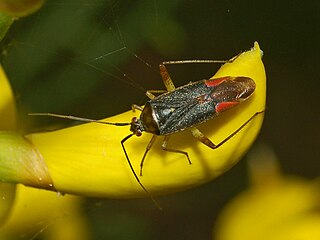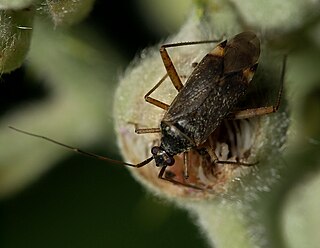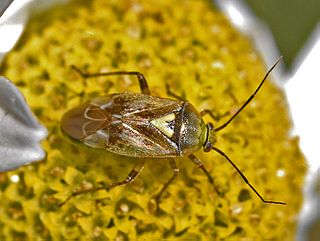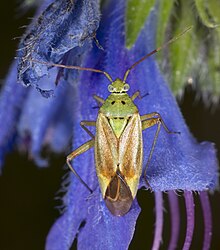
Hemiptera is an order of insects, commonly called true bugs, comprising over 80,000 species within groups such as the cicadas, aphids, planthoppers, leafhoppers, assassin bugs, bed bugs, and shield bugs. They range in size from 1 mm (0.04 in) to around 15 cm (6 in), and share a common arrangement of piercing-sucking mouthparts. The name "true bugs" is often limited to the suborder Heteroptera.

The Miridae are a large and diverse insect family at one time known by the taxonomic synonym Capsidae. Species in the family may be referred to as capsid bugs or "mirid bugs". Common names include plant bugs, leaf bugs, and grass bugs. It is the largest family of true bugs belonging to the suborder Heteroptera; it includes over 10,000 known species, and new ones are being described constantly. Most widely known mirids are species that are notorious agricultural pests that pierce plant tissues, feed on the sap, and sometimes transmit viral plant diseases. Some species however, are predatory.

Capsodes flavomarginatus is a species of plant bug belonging to the family Miridae, subfamily Mirinae.

Closterotomus trivialis is a species of plant bugs belonging to the family Miridae, subfamily Mirinae.

Lygocoris rugicollis is a widespread, common species of bug in the Miridae family. It feeds on a large variety of bushes and small trees, but especially willows and slightly less often alders. It can be found throughout Europe, including the UK, and Spain, in North Africa, as far east as Central Asia, in Alaska and Canada, including the Maritimes.

Deraeocoris ruberis a species of bug in the Miridae family.

Heterotoma planicornis is a species of bug from Miridae family.

Deraeocoris is a genus of plant bugs in the family Miridae. There are at least 210 described species in Deraeocoris.

Closterotomus fulvomaculatus is a species of plant bugs of the family Miridae, subfamily Mirinae.

Calocoris roseomaculatus is a species of bugs in the Mirinae subfamily of the Miridae family. It is found in Europe.

Tytthus is a genus of insects in family Miridae, the plant bugs. They are carnivorous, feeding upon the eggs of various planthoppers in the family Delphacidae, and thus are important in the biological control of pests. The genus is distributed throughout the Holarctic of the Northern Hemisphere, but species are also found in the tropics, in China, South America, Australia, and the Indo-Pacific.

Orthotylus is a genus of bugs from the family Miridae. There are more than 300 described species worldwide. The sheer number of species has led to the recognition of subgenera and groups, some of which may be promoted to genus level. Yamsunaga recognized the genus as non-monophyletic, and without consistent diagnostic characteristics.

Phylus melanocephalus is a European species of plant bugs belonging to the family Miridae, subfamily Phylinae. It is a slender bug 4.5–6 millimetres (0.18–0.24 in) long and feeds on oak trees. Its colour ranges from orange to greenish-brown and its head may be pale or dark.

Calocoris alpestris is a species of bug in the subfamily Mirinae of the family Miridae.

Lygus rugulipennis, the European tarnished plant bug, is a species of plant bugs of the family Miridae.

Closterotomus ventralis is a species of plant bugs belonging to the family Miridae, subfamily Mirinae.

Plagiognathus arbustorum is a species of insects in the family Miridae, the plant bugs.

Blepharidopterus is a genus of plant bugs in the family Miridae. There are about nine described species in Blepharidopterus.
Pseudomegacoelum is a genus of mostly European capsid bugs in the tribe Mirini, erected by Chérot and Malipatil in 2016. The type species, Pseudomegacoelum beckeri is recorded from northern Europe including the British Isles.
Pachytomella is a genus of mostly European capsid bugs in the tribe Halticini, erected by Odo Reuter in 1891. The species Pachytomella parallela is recorded from northern Europe including the British Isles.


















